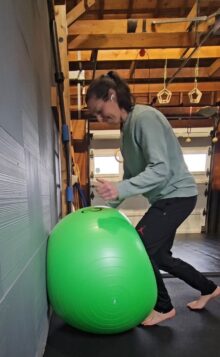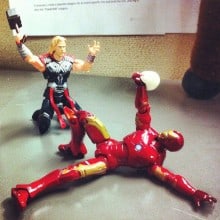Asymmetry. Up Leg. Compression. Push Down. Space. Rotational Organization. These all describe the physics of one half of the body accepting load, and one half of the body avoiding load. The first time I wrote about this, I referred to… Read more ›
In part 1, I suggested that using the knee as gas instead of brakes could help free up the knee for motion and elicit the hips and ankle-foot as stabilizers. For folks with chronic pain, however, their nervous system likely… Read more ›
Torsion. We all have it: a particular line of twist running through our carriage, gripping us in a certain way and keeping us upright. Each fold and joint tells its story, whether you realize it or not. It’s how we… Read more ›
While walking through the streets of Europe last Spring, Adarian Barr wondered why his feet felt so good. He traced it back to the cobblestones. The lift, the variability, the multiple points of potential folding. This was the impetus behind… Read more ›
Pairs. Roles. Asymmetry. The body knows and the body has ways. Understanding the differences between the halves helps you appreciate them. One side isn’t ‘good’. The other isn’t ‘bad’. They hold a function within the system. Here’s a big picture… Read more ›
This post serves as a follow up to: A Path Towards Harm. Otherwise titled: The things I did wrong when I didn’t pay attention or have compassionate patience. The tag to this blog used to read, “fix yourself.” But… Read more ›
This is the second post taken from the mind of Nicole Uno. It is a continuation of the first, explaining Rotational Organization. For the most part, we are floating. Skating and tip-toeing off the ground because we can. We have… Read more ›
Interest dictates pretty much everything. It is the neck that turns the head and keeps curious eyes fixed. At its most illuminating and significant, it attracts the onlooker into their own inner workings. Believe that you are both interesting and… Read more ›
The following is part two of my course notes and findings from Stress, Movement, and Pain. As practitioners seeking to help bio-psycho-social organisms, we have to be able to read, analyze, and gather information from all three dimensions. The… Read more ›
The following is a glimpse into the mind of Nicole Uno (IG @unotraining). Rotational Organization allows for the simultaneous existence between contract and relax. Thoroughly simplified, consider two gears. There is an impetus of force and a corresponding area… Read more ›
A PE teacher on one side of the country texts her trainer pal on the other. “I was thinking of getting this textbook for my weightlifting class.” “Why do you need a textbook?” “So I have something to reference… Read more ›
Two years ago, I set to develop a “new” type of PE that looked outside the realms of sport and weight lifting. With the outliers as my muse, we set to examine movement with a larger lens — how one… Read more ›
If you’re curious about why only half a workshop I’ll tell that story at the end. Tom Weksler’s Movement Archery workshop was a lesson in angular momentum. We rolled, we spun, we bruised our pointy bits. Imagine an archer… Read more ›
Joint ‘popping’ is a curious thing. It alarms without hurting. Especially when you realize it wasn’t there before. You notice something is different when you do that particular thing in that particular way. The different becomes ‘less than’ when… Read more ›
Engaging with your work demands a certain degree of ownership. There must be a benefit to the challenge presented, beyond just a hard-to-apply confidence. A task can serve as a test of will, a test of adaptability, and/or a test… Read more ›
Doing without knowing. Playing, creating, learning. Adjusting and adapting. Describing Fighting Monkey is an act in organizing verbs. Everything overlaps and intertwines and is a wonder. The only certainty you are left with is that you have experienced something good… Read more ›
Issues with joints or body parts can almost always be traced back to usage. When faced with a familiar task in a familiar environment, our habitual patterns of movement follow a particular chain of command. We clutch and are clutched… Read more ›
“I’m going to explore the depths of the ocean.” “You’re gonna what?” “I’m going to get into this magical pressure suit, close myself off to the known world, and look for cool stuff.” “Why would you want to do… Read more ›
Movement overlaps. Brain work = joint work = speed, power, strength, and coordination work. We have structures and we have capacities. Our practice establishes the abilities of both. There is a general consensus that if your parts work better you’ll… Read more ›
Body control is all the rage. A popular want is increasing active range of motion. People want to get there so they can do stuff there. Functional Range Conditioning uses slow, controlled movement to examine individual joints, build capacity in… Read more ›
Hip extension is a vital movement to both health and performance. Wellness wise, hips that can extend, coupled with an unstuck spine and pelvis that can naturally posteriorly tilt, means you likely don’t suffer from back pain. Power and speed… Read more ›
This post serves as a companion piece to Pain Exploration: Medial Knee. It picks up right where it left off, with manipulations of the ankle, foot, and toes. A low sit with the heel up and toes extended (an expression… Read more ›
Increasing dorsiflexion is a popular yet frustrating goal. Getting the ankles to do more lessens the strain on the knees, and is an important factor in being able to drop into a deep squat — an often used marker of overall… Read more ›
Pelvic motion and knee flexion influence hip rotation. Structures above and below a joint have a direct impact on the way it functions. For the hip, its surrounding articulations are the knee and the pelvis. Stiffness or motion in… Read more ›
We tend to move in ingrained patterns, within the same degrees and utilizing the same amount of space. Thinking bigger about what a joint is capable of doing allows us to use it in ways we don’t, which often aligns… Read more ›
Sliding is one of the most fun ways to get from here to there. True to form, it’s also a sneaky little way to grasp an underlying understanding of movement. F=ma (force equals mass times acceleration) is explained in… Read more ›
Ah, gravity. The beautiful constant. 9.8 meters per second (squared) you can rely on again and again to hold you down. Many times we see it as our enemy, a hindrance to our speed and power. But in the world… Read more ›
featured photo credit: @movnat instagram (Carlos Condit) The ground is a safe, secure place. It is not something to be avoided or stepped lightly onto. It can easily absorb our falls and placements and pressures. If we become afraid… Read more ›
The one flaw in the Functional Range Conditioning system is its heavy use of acronyms. It has created a culture of separation, utilizing a language only understood within the context of the FRC group. Starting with CARs and developing into the… Read more ›
As examined in my previous post, joint function defines what kind of movements you are prepared to perform. Articular independence must come before articular interdependence. The ability to isolate a particular joint leads to more control, increased awareness, and lessening… Read more ›
The popular — and still conceptually relevant — joint-by-joint approach championed a decade ago lent logic to the idea that a problem that revealed itself in one area may be caused by dysfunction in another. There were stable joints, and there were… Read more ›
Functional Range Conditioning (FRC) is a system of creating, controlling, and expanding useable range of motion, defined as mobility. Unlike flexibility which is typically achieved passively, FRC uses tension and isometrics to minimize neurological safeguards that inhibit mobility in the… Read more ›
Yesterday, Guido Van Ryssegem was gracious enough to speak to us at the Free Salem Fitness Summit. While his topic was “Resolving Upper Extremity Movement Dysfunctions”, he delivered plenty of nuggets regarding motor learning in general. Here are three gems I… Read more ›
If you’re stuck in a movement plateau, changing the direction in which you impart force into a joint will often translate into greater mobility. The body reacts in function what is demanded of it by stress. Andreo Spina describes this… Read more ›
Like so many explorations, I have a personal connection with neck issues. I got crunched once quite solidly in a rugby ruck and felt a terrifying lightening bolt go through my body. My neck hasn’t been the same since. Then,… Read more ›
Getting off and onto the ground is a skill that isn’t practiced by the larger population. We have chairs and beds that are soft and inviting. Babies spend most of their time on the floor, and they seem to have… Read more ›
What is Movement Based Training?A systematic approach to mastering movement. It is an attempt to restore full functional movement capacity of the human body. All you need is some space (and preferably a cushioned floor). Who Came Up With… Read more ›
When the U.S. military realized a third of their young people weren’t fit for combat, they mandated that physical education be taught in any school that receives federal funding. Students did regular calisthenics. We moved our bodies in large groups… Read more ›






































